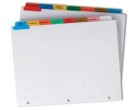 After 15 years as a key technologist at RR Donnelley, Tom Clifford was looking for a change. He chose another venerable company, 125-year-old HCMiller, as a new environment where he felt he could make a big difference. Senior Editor Cary Sherburne spoke with Clifford to see how things are going for him and for HCMiller since he joined the company in 2010 as Director of Digital Development.
After 15 years as a key technologist at RR Donnelley, Tom Clifford was looking for a change. He chose another venerable company, 125-year-old HCMiller, as a new environment where he felt he could make a big difference. Senior Editor Cary Sherburne spoke with Clifford to see how things are going for him and for HCMiller since he joined the company in 2010 as Director of Digital Development.
WTT: Big change … what attracted you to HCMiller?
TC: The company’s heritage is in filing products and print services, along with a printing equipment sales/service/brokerage division. It is a very different environment than I came from. It’s an employee-owned company, and I felt there would be much more opportunity to make a difference. It is amazing to be part of something and to know that the difference you are making is going to add to your share value. I love that.
WTT: Tell us what you mean by filing products.
TC: This includes custom index tabs, binders & folders, legal index dividers, and more. For example, you might see our products when you go to the doctor. You might see racks of color-coded file folders, or perhaps when you see a tab in the yellow pages or a catalog.
WTT: So we are talking about products that help people keep paper organized.
 TC: Basically, yes. And as things go more digital in the world of filing, the company was looking for new products and services to augment its base. They had just purchased a Xerox iGen and had a web-to-print solution, but really weren’t into the marketing services arena. They didn’t offer variable data, cross media, mobile solutions…but they had the skeleton in place to allow them to do so. They had the expensive pieces of the puzzle but no overarching strategy. That’s where I felt I could be valuable.
TC: Basically, yes. And as things go more digital in the world of filing, the company was looking for new products and services to augment its base. They had just purchased a Xerox iGen and had a web-to-print solution, but really weren’t into the marketing services arena. They didn’t offer variable data, cross media, mobile solutions…but they had the skeleton in place to allow them to do so. They had the expensive pieces of the puzzle but no overarching strategy. That’s where I felt I could be valuable.
WTT: What did you bring with you from your RR Donnelley experience?
TC: When you leave a company after 15 years, you are coming from a place where people know who you are and what you are capable of. When I came to HCMiller, I wanted to prove myself as a valuable component to the equation. So I started by solving problems. I felt this was an important aspect, allowing me to build trust with my fellow employees. If they trust you with the small things and you deliver, they will trust you with bigger things. Coming into a new company, especially from a large, well-known company like RR Donnelley, it is totally important to go in with an attitude of,’ Oh, sure, I can solve that.’ And if I couldn’t solve it, I got back to them with what it would take or why it can’t be solved. The last thing I wanted to do—and a mistake many people make, I believe, in such a transition—is to come in saying, ‘Oh, you should be doing this … that’s what we always did at my previous company.’
WTT: So that was a good start, and I am sure was a great way to get to know the strengths and weaknesses of the new company.
TC: Yes. That’s where it started, and then my next step, which is still ongoing, was to figure out how we can take fingerprints out of the system and streamline our processes.
WTT: What was the web-to-print solution that was in place?
TC: We had—and still have—Pageflex, but we weren’t utilizing it to its full capacity. We didn’t have a central focus point, and people were frustrated. The bottom line is we bought a cart and provisions, but didn’t have any horses. Now we are on a path. We have a strategy in place, and we understand the plusses and minuses of it.
WTT: Are you using it across the board in the business? You have three pretty distinct businesses going on—marketing services, filing products and equipment sales.
TC: We are using it in the print area, which includes both organizational products and marketing services. We have some pretty large customers who have their collateral on there. We also have legal firms with multiple sites and other customers of our organizational products that can order these products from a branded site. We aren’t using it in the equipment area where we are a broker and don’t really have a specific product. And of course, we are using it in the marketing services area. It is a longer sales cycle to build those marketing relationships, especially since we didn’t offer anything like that before and certainly weren’t known as marketing specialists.
WTT: After two-plus years of building this business, what percent of revenues is represented by the marketing services offerings?
TC: It’s about 20% and is climbing. We know the medical index tab area is declining, but in legal they still are pretty paper-intensive, so we don’t see much decline there—yet. One of our advantages, across both the organizational and marketing services businesses is that we have everything in-house and we are able to do things very efficiently with an economical price point that allows us to be extremely competitive. Also, we are diversified enough that we are protected from the ups and downs of the various segments. We have some pretty solid competitors in the U.S. and Mexico. But our Lean and 5S initiatives have allowed us to take a great deal of waste out of our process and be more efficient than the competition. That shows in our pricing structure, but more importantly, we always had a superior quality advantage, only now the price gap is no longer a viable consideration for our customers.
WTT: Adding marketing services, and especially cross-media, was quite a leap from the traditional business.
TC: It certainly was. Cross-media by its very nature touches many different things. You can have a social media component, for example, and a mobile component. We have partnered with MindFire as a cross-media partner and have a great relationship with them. Many of our campaigns use QR codes. As we speak, we are working on a campaign for a health provider in Michigan that uses QR codes and a mobile-optimized experience.
WTT: How are you viewing the mobile opportunity?
TC: Mobile doesn’t necessarily have to mean cross-media. It might be building a mobile website for a restaurant as an example. You have to think about what people want when they look up a restaurant on their phones. They want to know what’s on the menu, whether seating is available. They may want to know what the atmosphere is like and you can show that with photos or videos. Less than 50% of local and regional businesses even have a mobile strategy, so the mobile portion of our business can rest on its own, as can cross-media.
WTT: What about social media?
TC: Our approach there is to build the strategy for clients and then partner with local companies in the area that help with the execution. Basically we say that we will teach them how to do it and then work ourselves out of it. We will do it for them for six to eight months, but then we want them to own it. If they don’t own it, it will be dead.
WTT: What do you find is the most important aspect for clients who want to participate in social media?
TC: You need a top-down strategy to enable social media to be executed in an organized, trackable and calculated manner. You can throw mud on the wall and see what sticks, but if you don’t know what you are getting out of it, how do you know if it is successful? You need to have goals and objectives, and metrics that you can use to determine if you are reaching those goals and objectives.
WTT: What about personally? You were pretty visible, at least in some circles, when you were with RR Donnelley.
TC: That’s one of the things I love about working for HCMiller; they understand the value of having key employees out there networking, speaking, using social media. It helps the individual and the company be top of mind. It builds credibility both personally and for the company.
WTT: Are you doing anything with tablet apps? It always seems strange to me that more printing companies don’t jump on the opportunity that provides—you have the assets and the content for a brochure or book. Why not augment that with an app that overlays rich media for a different type of experience?
TC: We are starting to work with educational publishers, and in that vertical, there is a lot of talk about the iPad thing. Still, for text books, people still gravitate to having the print in their hand. We are working on technology and tools that will take a currently printed text book and augment the experience. For example, in social studies you might be learning about Paris. You could move your iPad or tablet with a camera over a page, and up pops a 3D picture of the Eiffel Tower. You can zoom in, look at it, and gain access to more in-depth information about it. The teacher knows that the student looked at that extra content. This is where we are beginning to dabble with augmented reality, where we are seeing the focus, because that will augment our print sales as opposed to cannibalizing our print sales.
WTT: So that’s another hot point with me. Printers don’t want to do a lot of the new stuff because they are afraid it will cannibalize their print business. But in my humble opinion, print volumes will be cannibalized with them or without them.
TC: You are right; it is going to happen anyway. We need to understand that we can sit by and watch it happen, or we can lead people to how we want it to happen. There are plenty of print opportunities out there; we just need to sharpen our sales skills and go get them. That, coupled with a properly aligned marketing services focus, can help drive print. Print is not dead, just evolving. There are a lot of printers sitting back and watching the changes happen around them. I guess that’s an advantage for us, but not so good for the industry as a whole. Our approach is to pick a couple of new things, be a mile deep in those things, and then when we get good at those, we can add more. We’re not trying to do everything at once.










Discussion
Join the discussion Sign In or Become a Member, doing so is simple and free